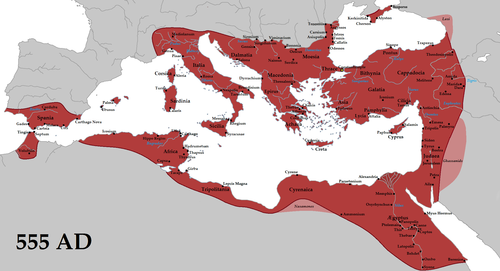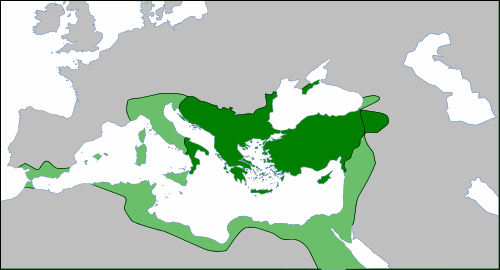Byzantine Empire
 From Wikiversity - Reading time: 2 min
From Wikiversity - Reading time: 2 min
The Byzantine Empire directly succeeded in the Ancient Roman Empire, and while it was originally the eastern half of the early Roman empire, at times it controlled most of the coastal regions of the Ancient Roman empire. The empire had endured the crusades and plagues, the Mongol invasion and the eternal war which raged in Europe during the medieval times.
Diocletian to the fall of the Western Empire
[edit | edit source]The Roman Empire had been divided by the emperor Diocletian, who created two empires—the Western and the Eastern. The Empire was rejoined and divided a few times through the 4th century, but the final division came in 395. The Western Empire was doomed to fall to the Barbarian hands, but the Eastern Empire sustained its freedom due to the strong battlements on the Danube and the fact that any Barbarians who crossed the Danube could be more easily defeated by the Byzantine armies or bribed by the immense treasury of the Eastern Roman Empire. In 476, the Barbarian warlord Odoacer became king of Italy and this was the end of the Western Roman Empire.
Justinian
[edit | edit source]In the 6th century, a Byzantine emperor called Justinian captured many of the key lands that had belonged to the Western Roman Empire. This resulted in the Byzantine Empire reaching the size shown in the map below:

7th century-1204
[edit | edit source]
After Justinian's expanded empire, the Byzantine Empire shrank significantly due to various problems, including the Islamic conquests. These conquests brought formerly Byzantine holdings under Muslim control and ultimately led to many of the Muslim countries that exist today. However, in the form of what's now Greece, along with Asia Minor (now Turkey), the Byzantine Empire was able to survive, reaching the extent shown in the diagram in 1025, before Crusades and more Muslim advances would result in the first fall of the Byzantine Empire. A crusade at the end of the 11th century captured lands for Christianity as far south and east as Jerusalem, although Jerusalem did not become a part of the Byzantine Empire at this time.
1204-1453
[edit | edit source]In 1204, the Crusaders conquered Constantinople, the capital of the Byzantine Empire, and therefore the Byzantine Empire no longer existed. However, in 1261, Byzantine was recaptured and the Byzantine Empire was revived. However, the Ottomans eventually captured Constantinople in 1453 AD, and the Byzantine Empire fell for its final time.
 KSF
KSF